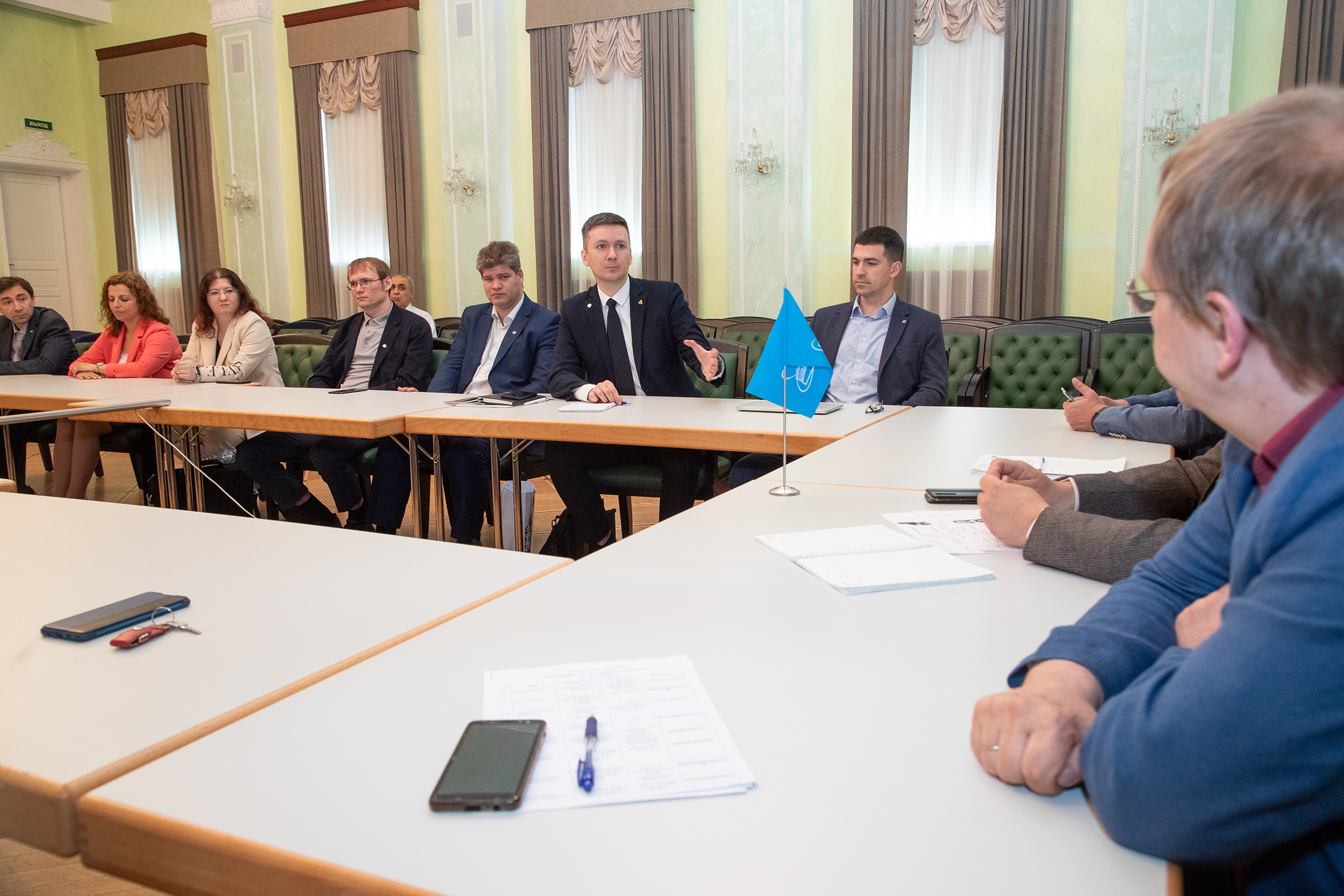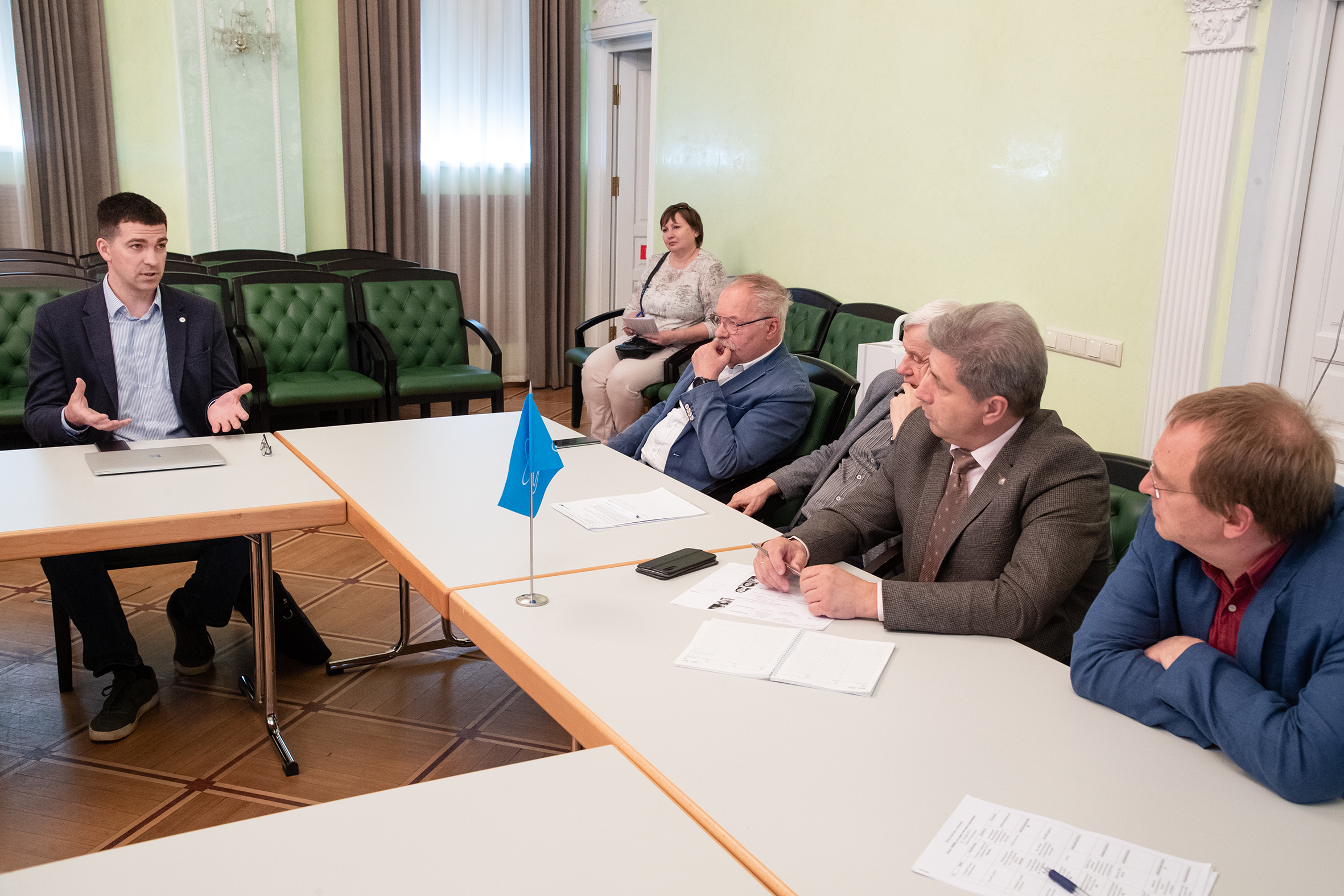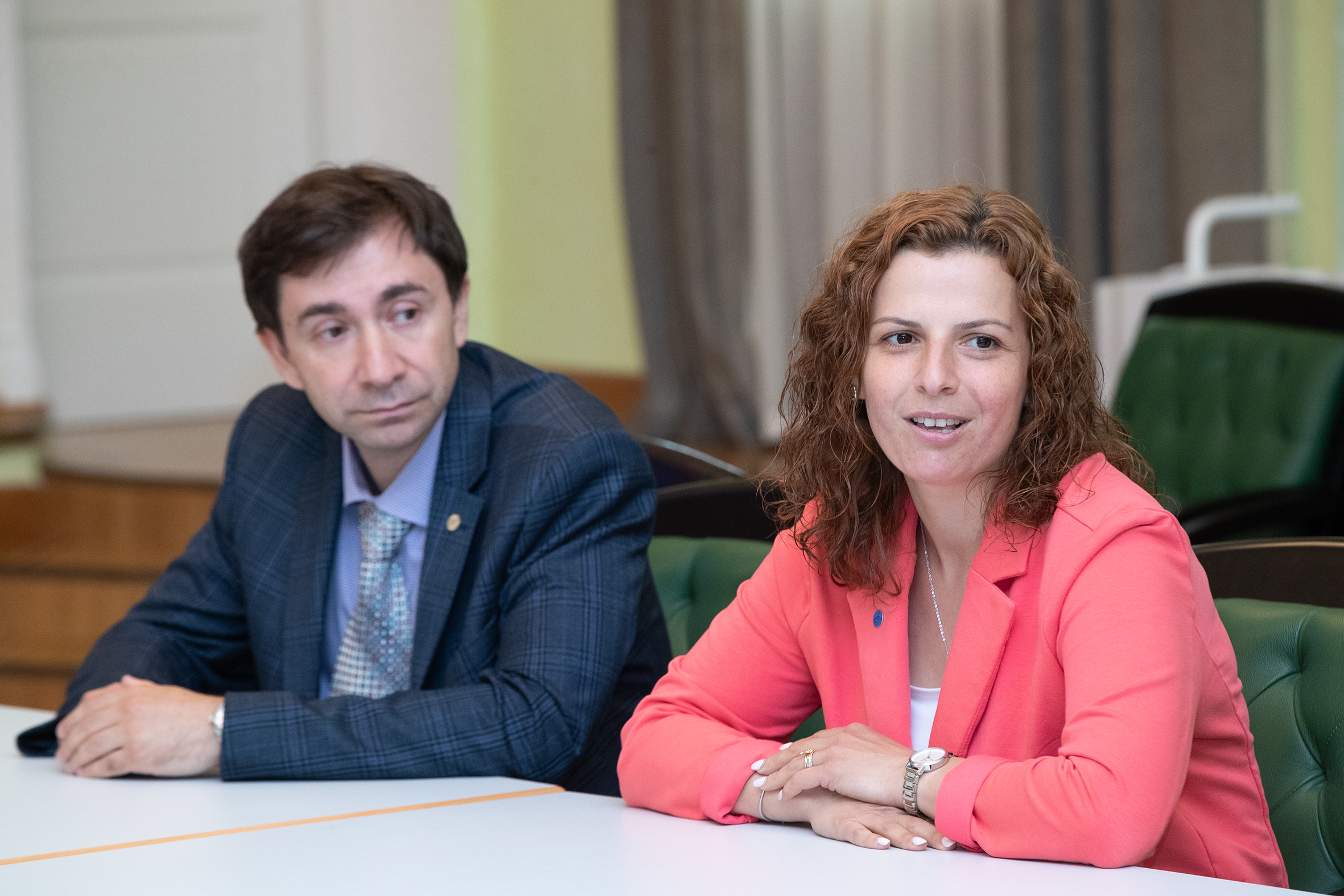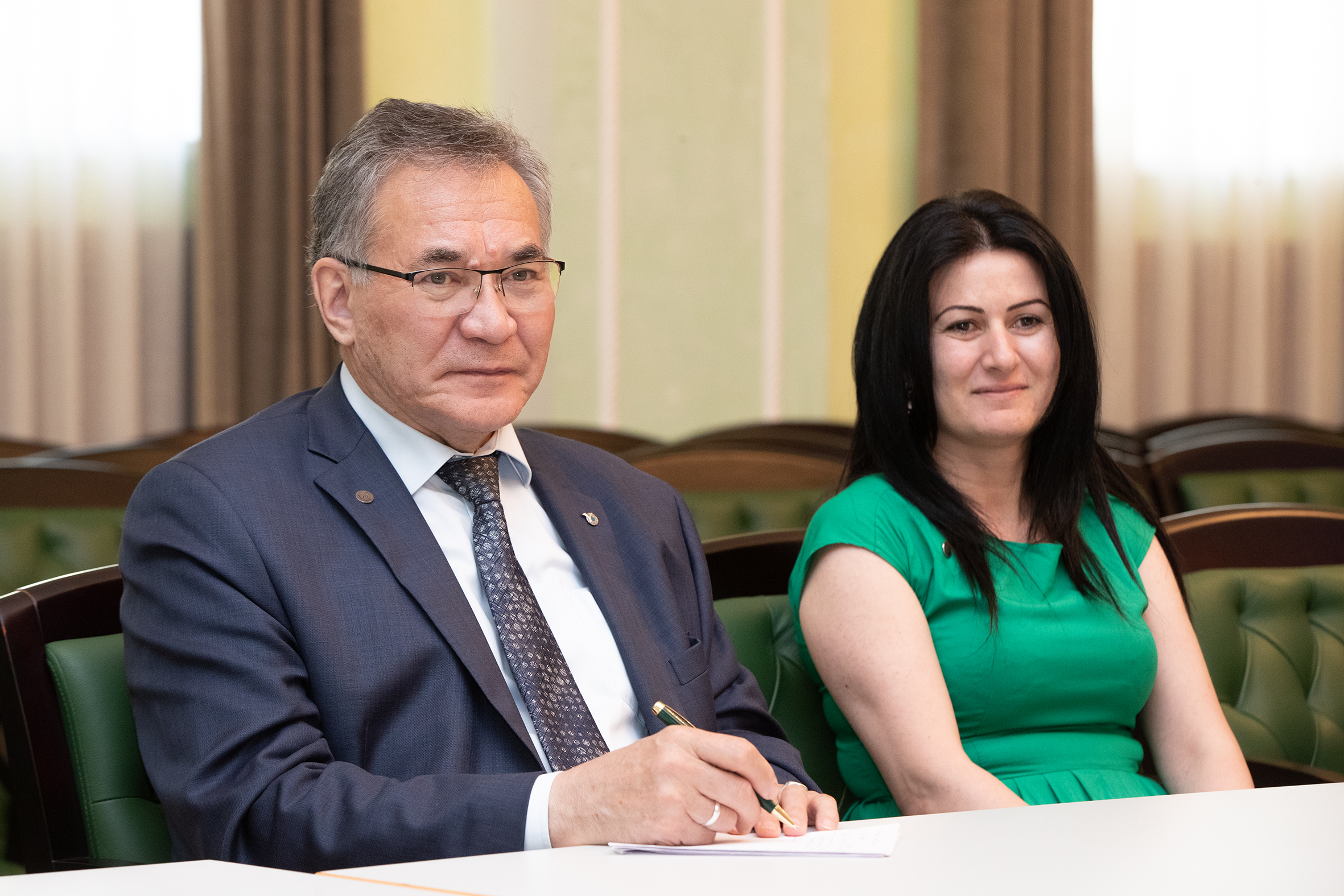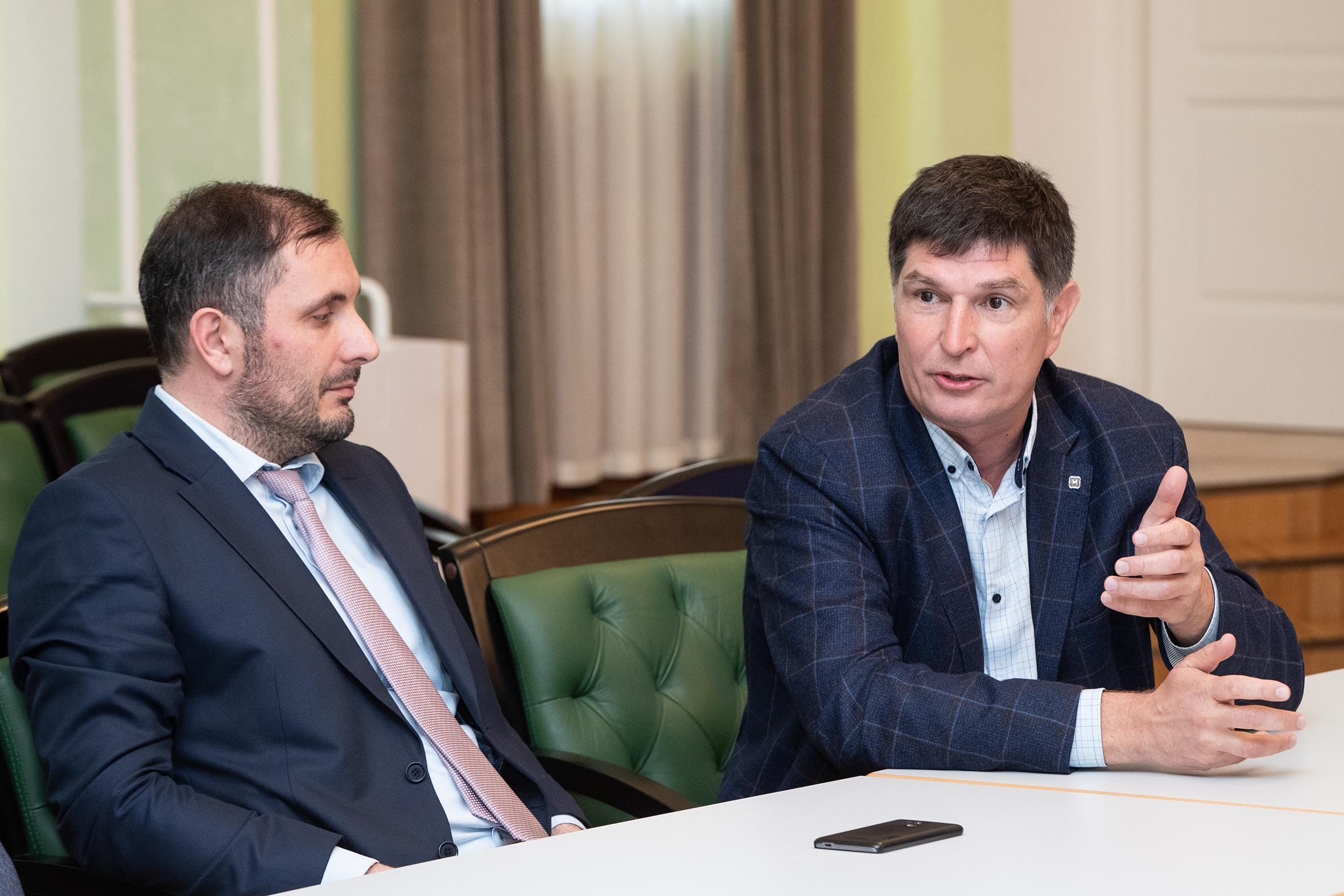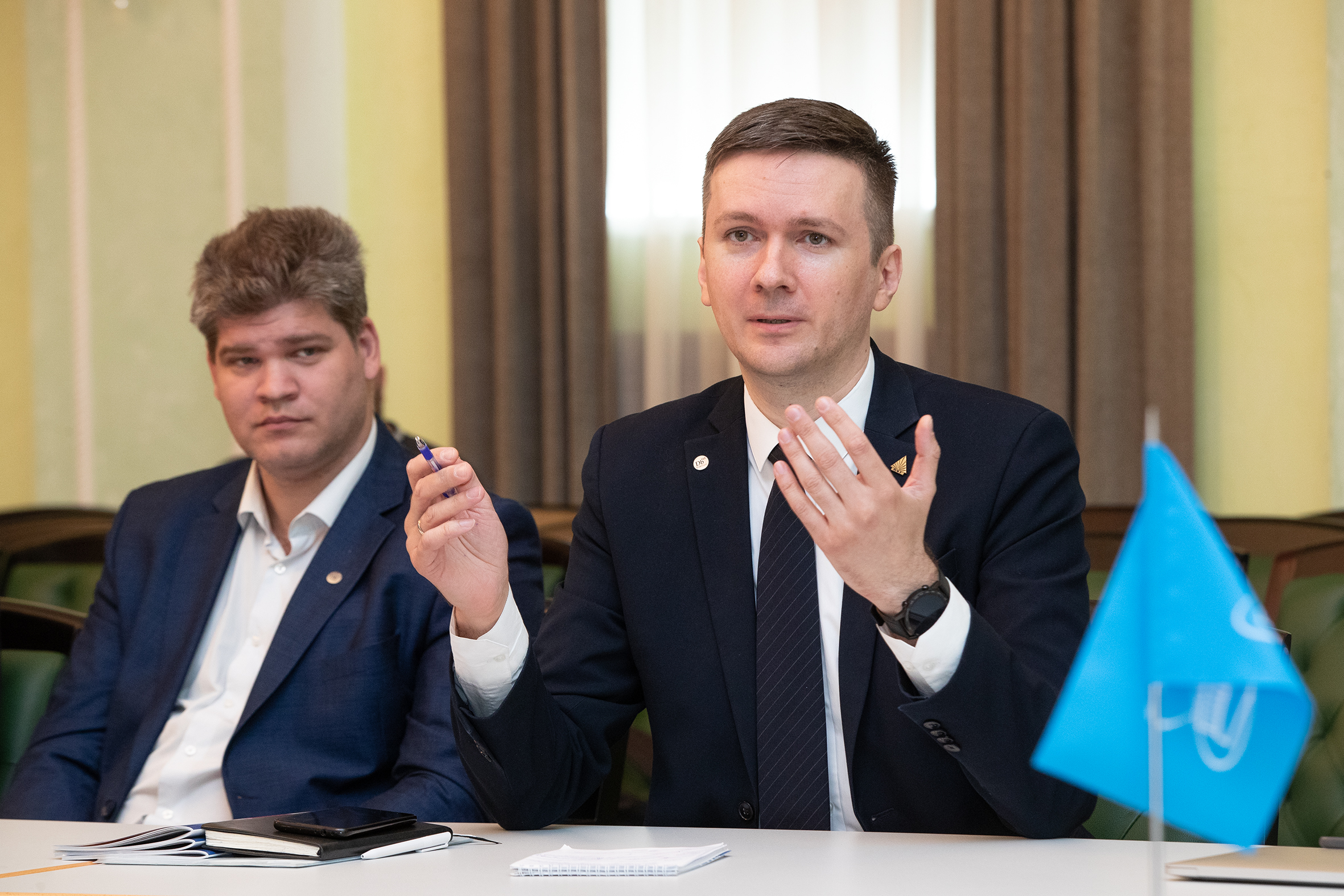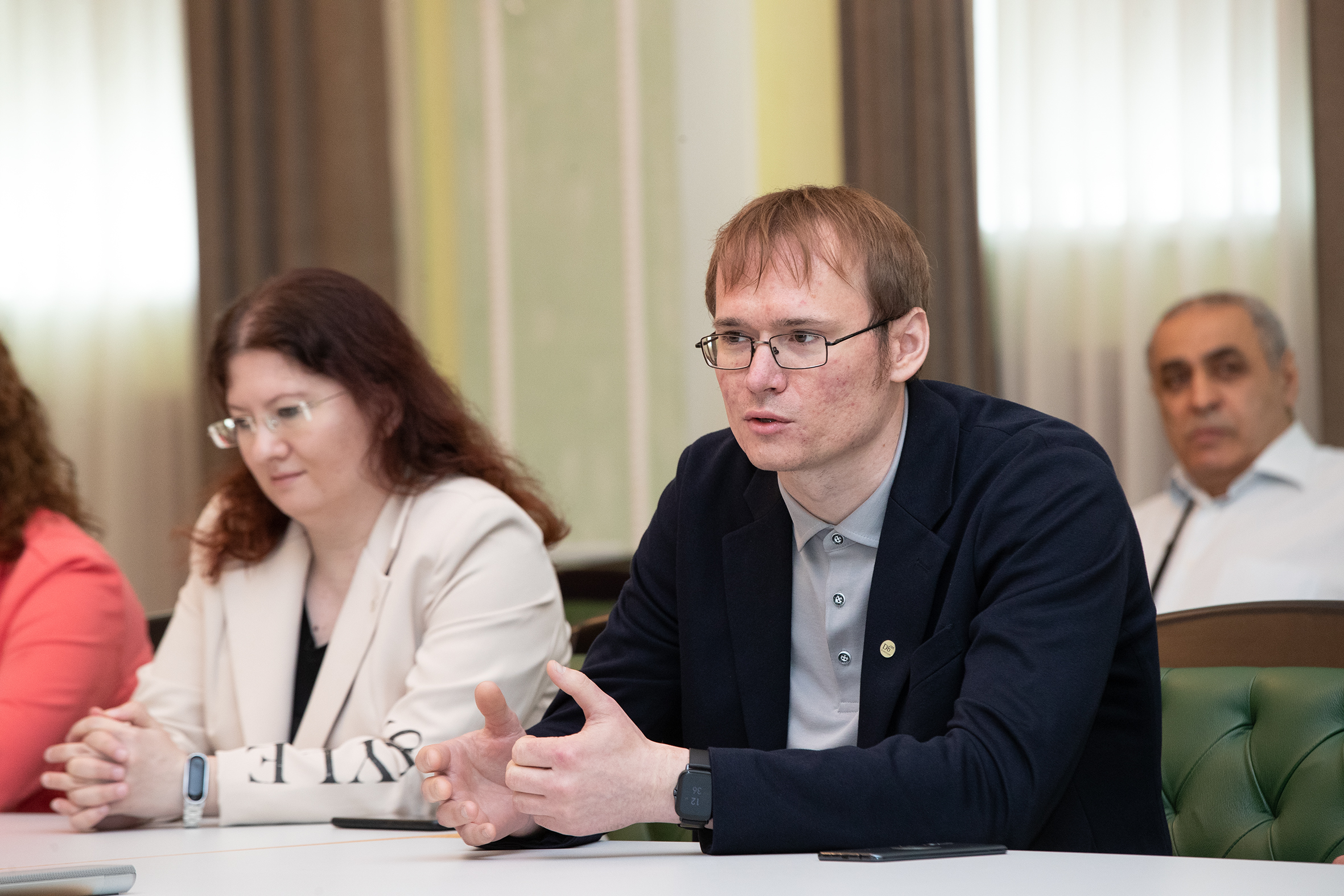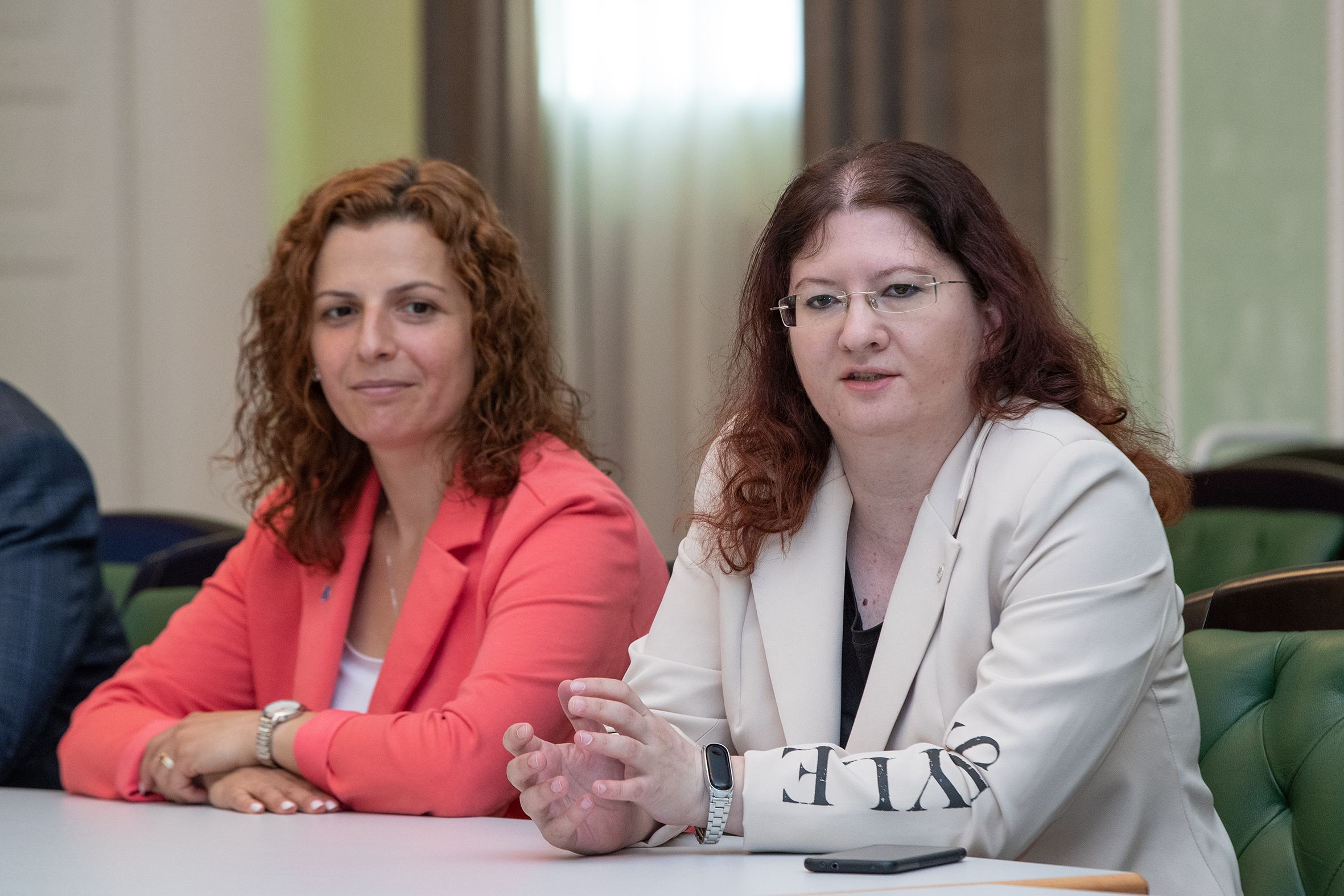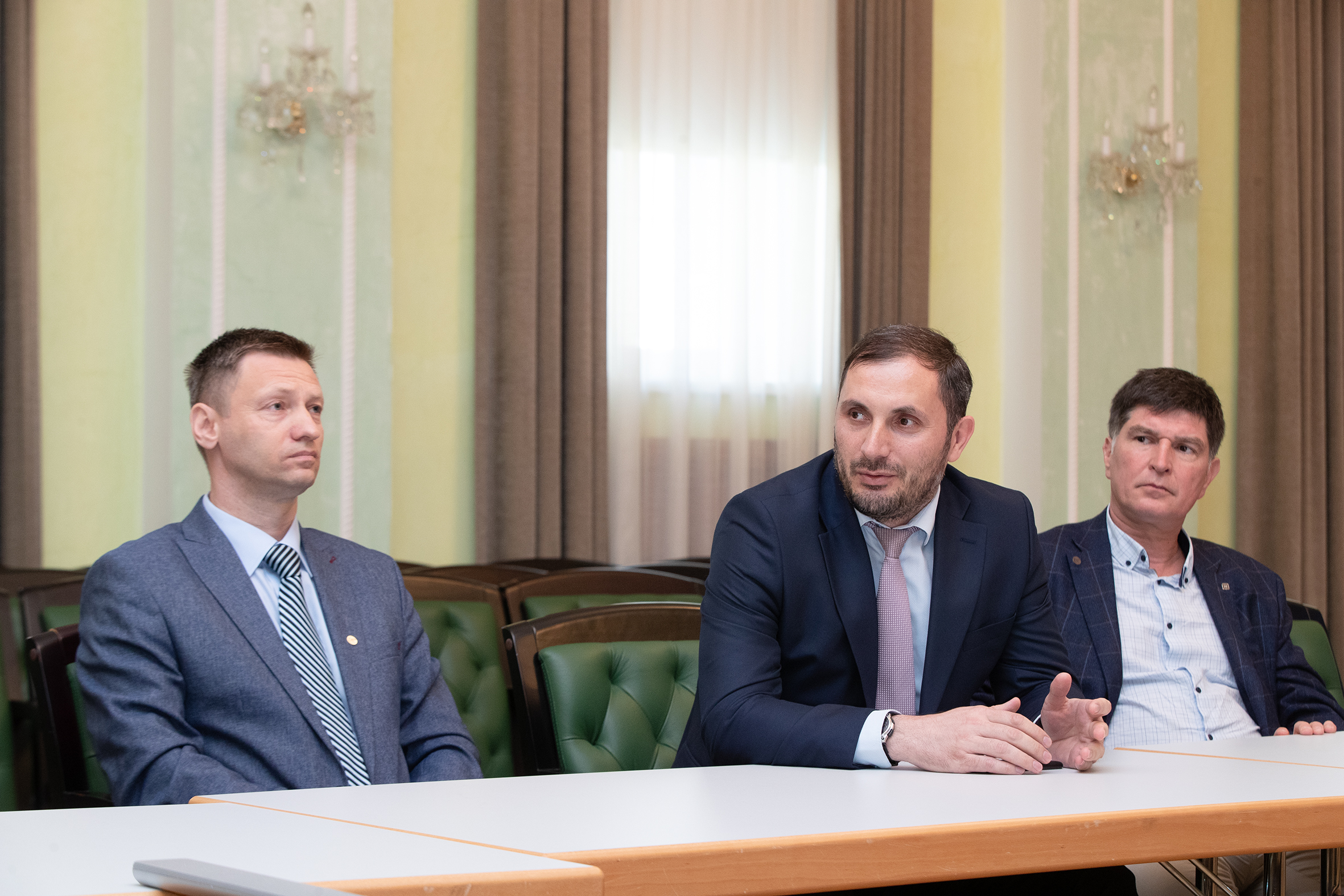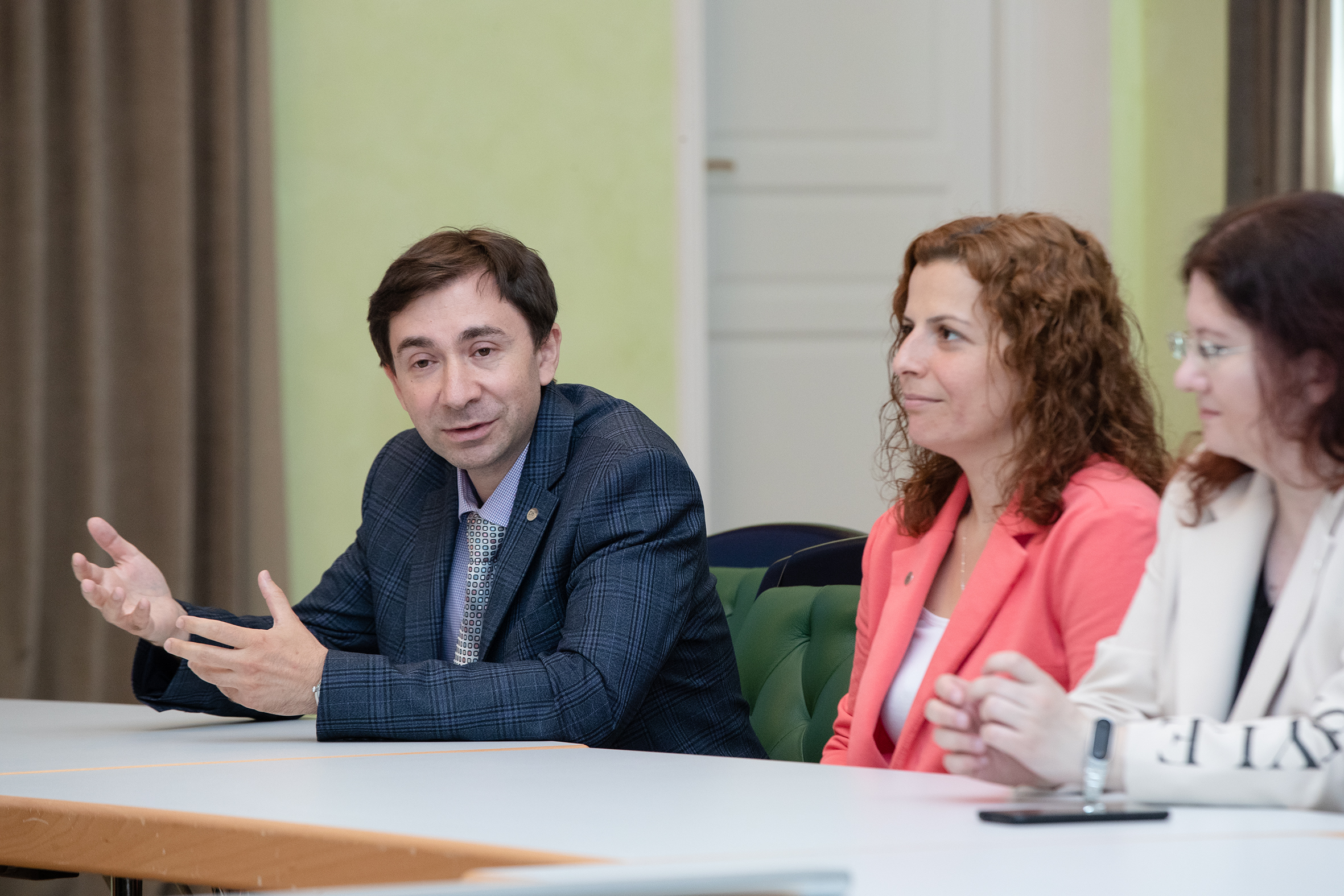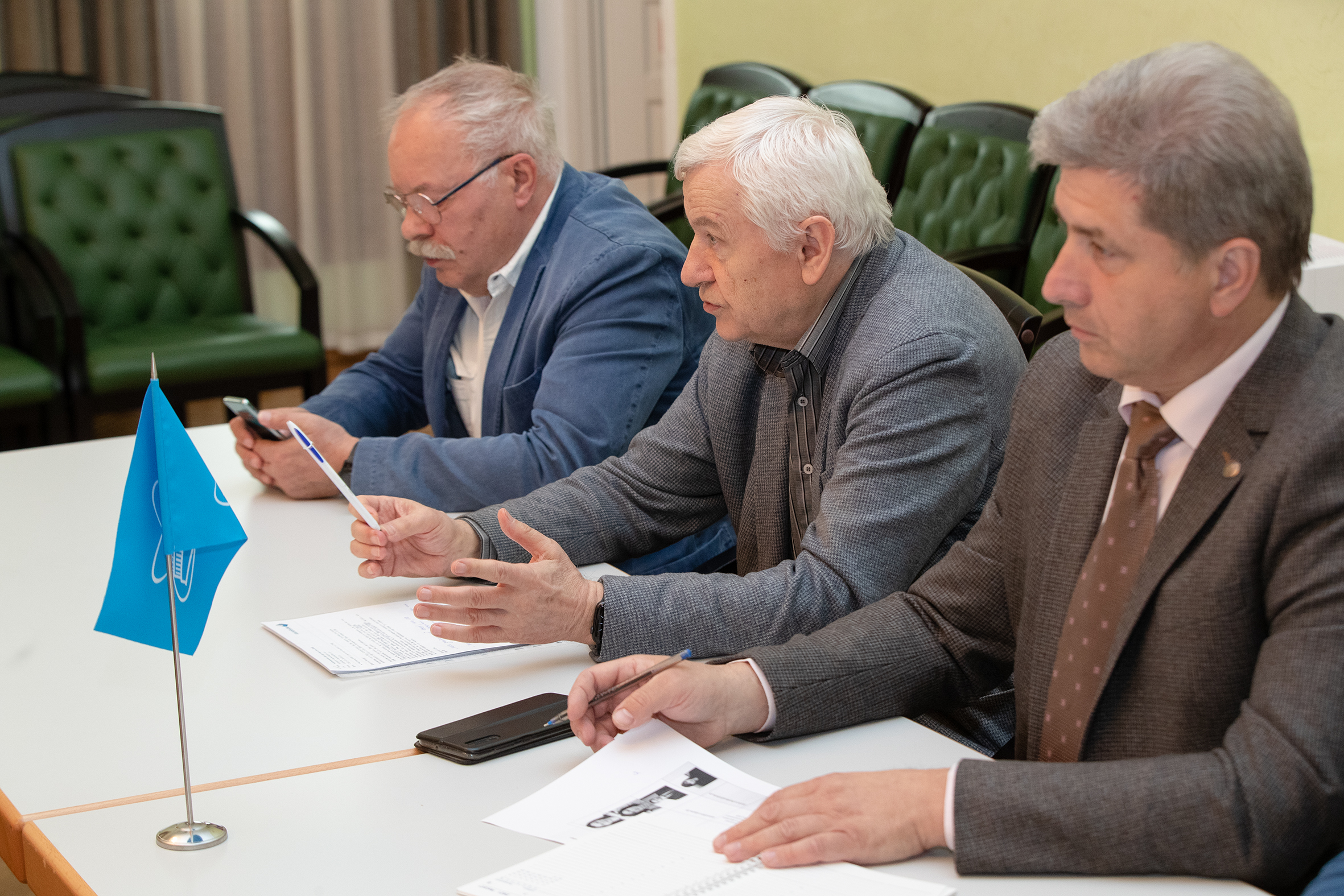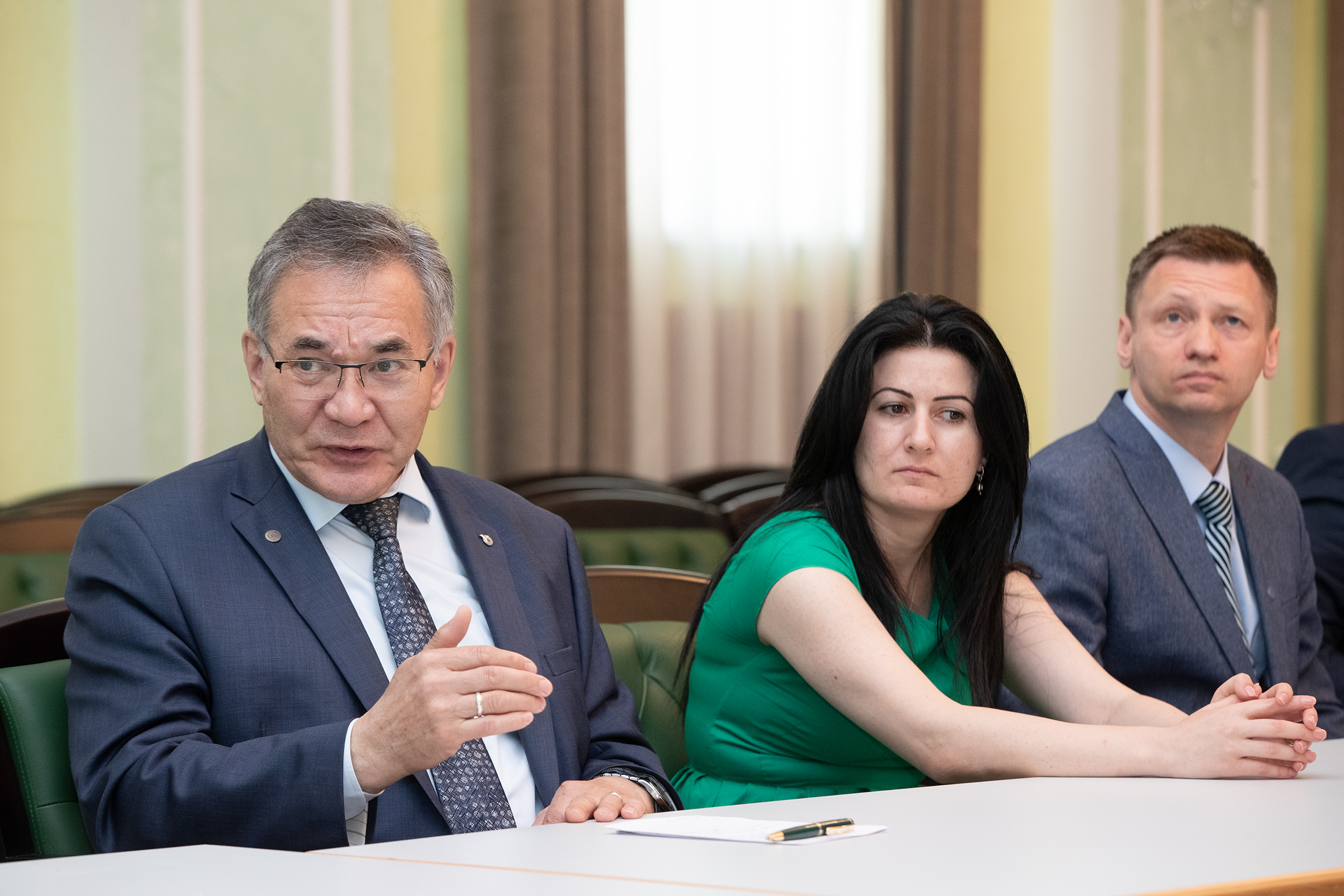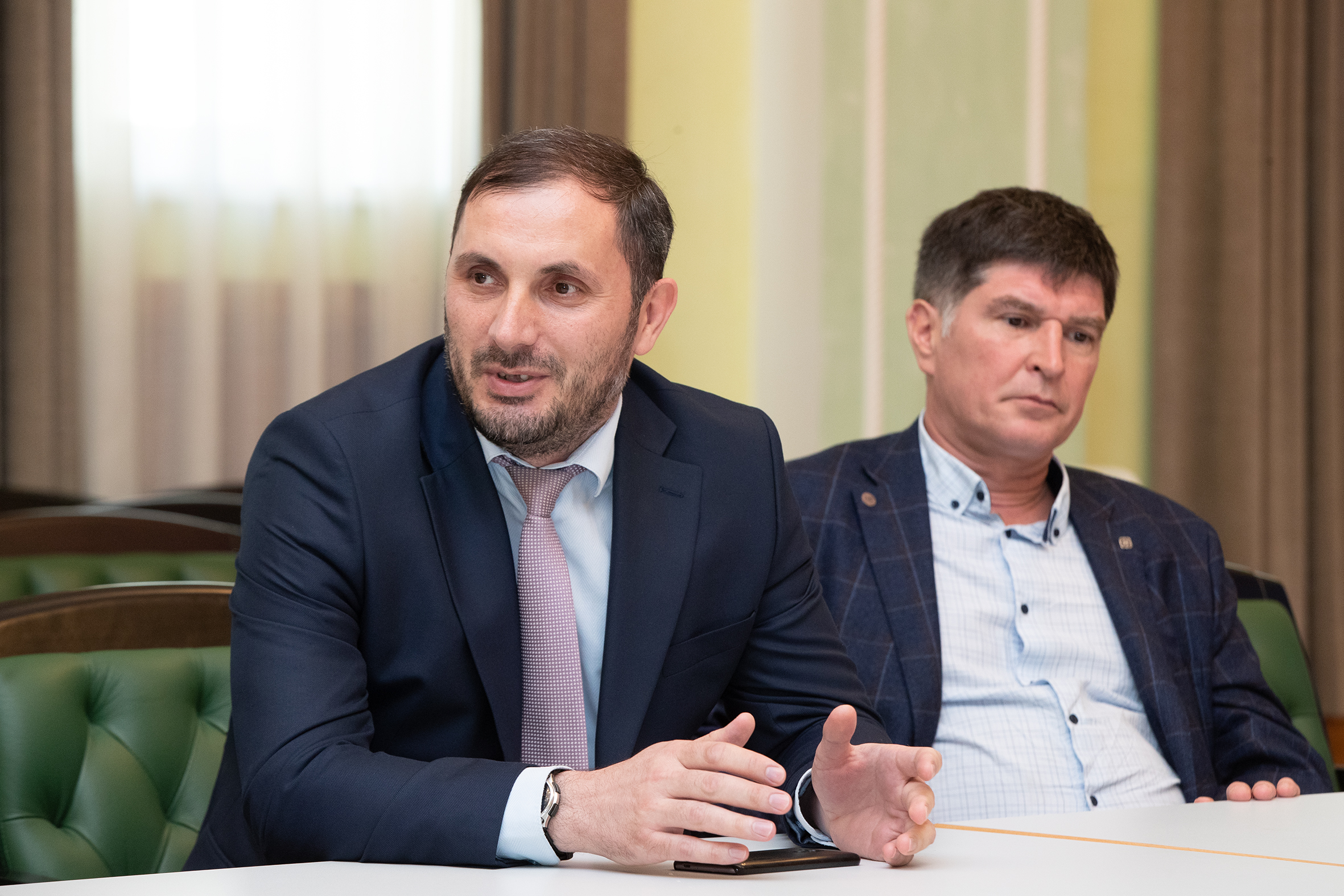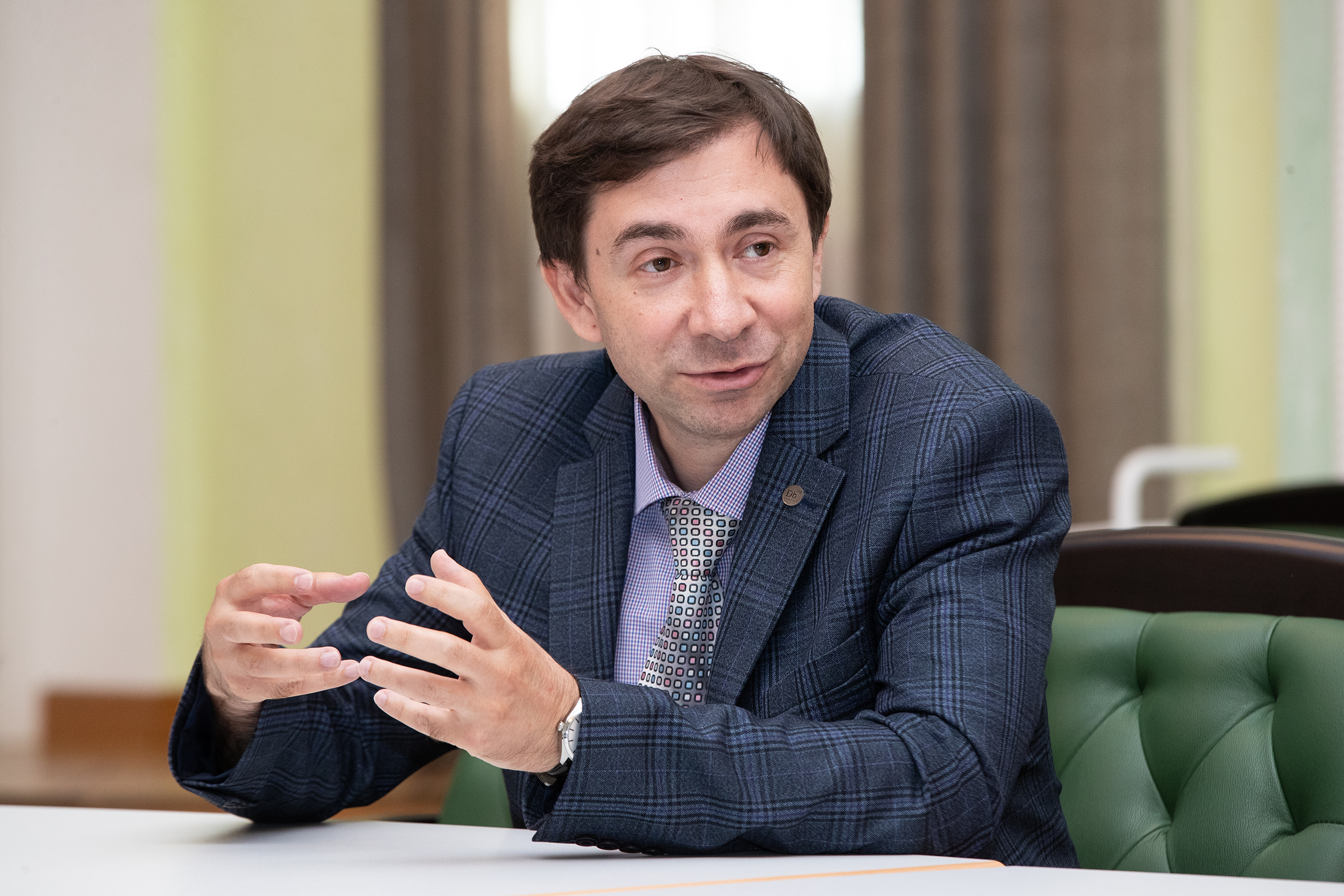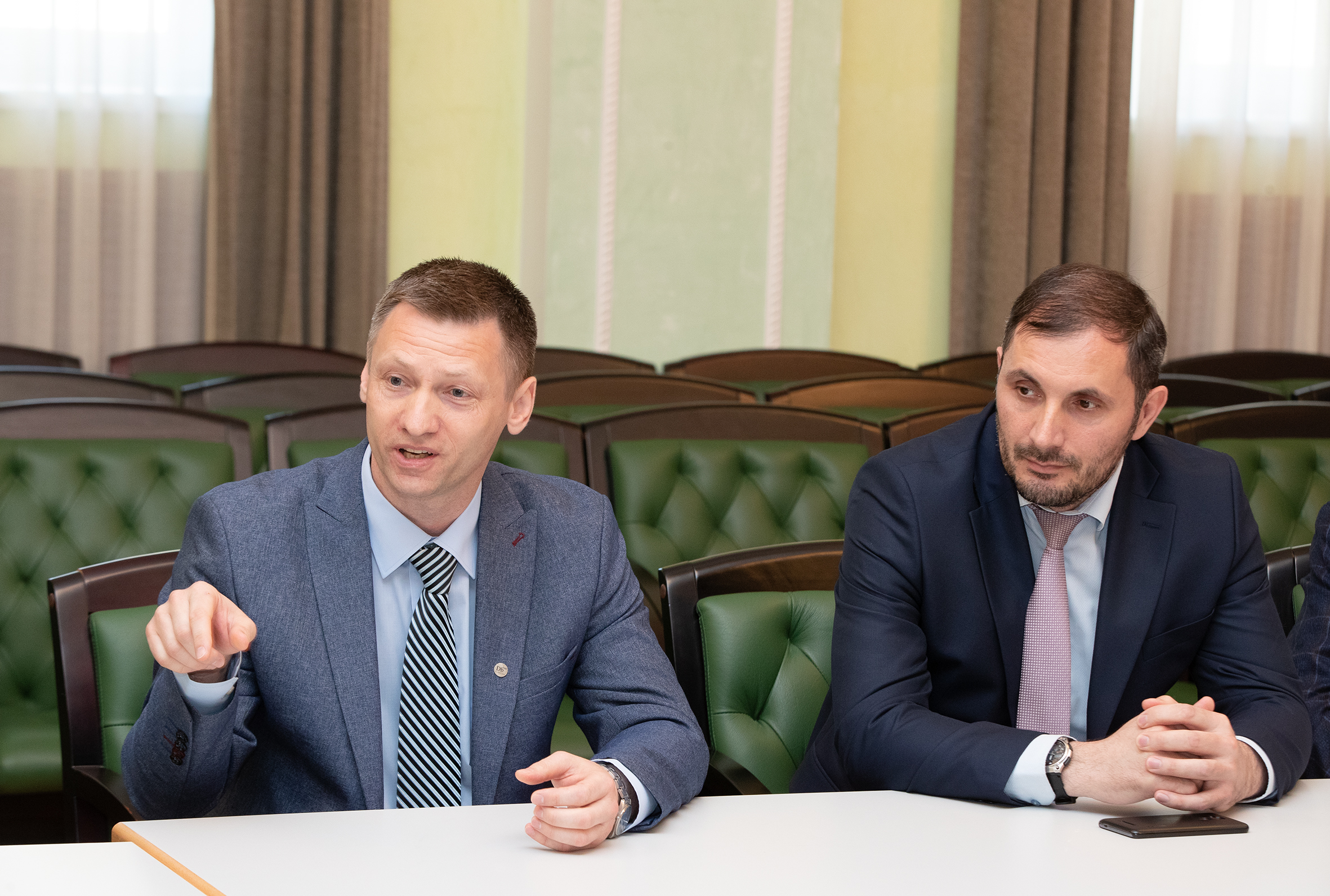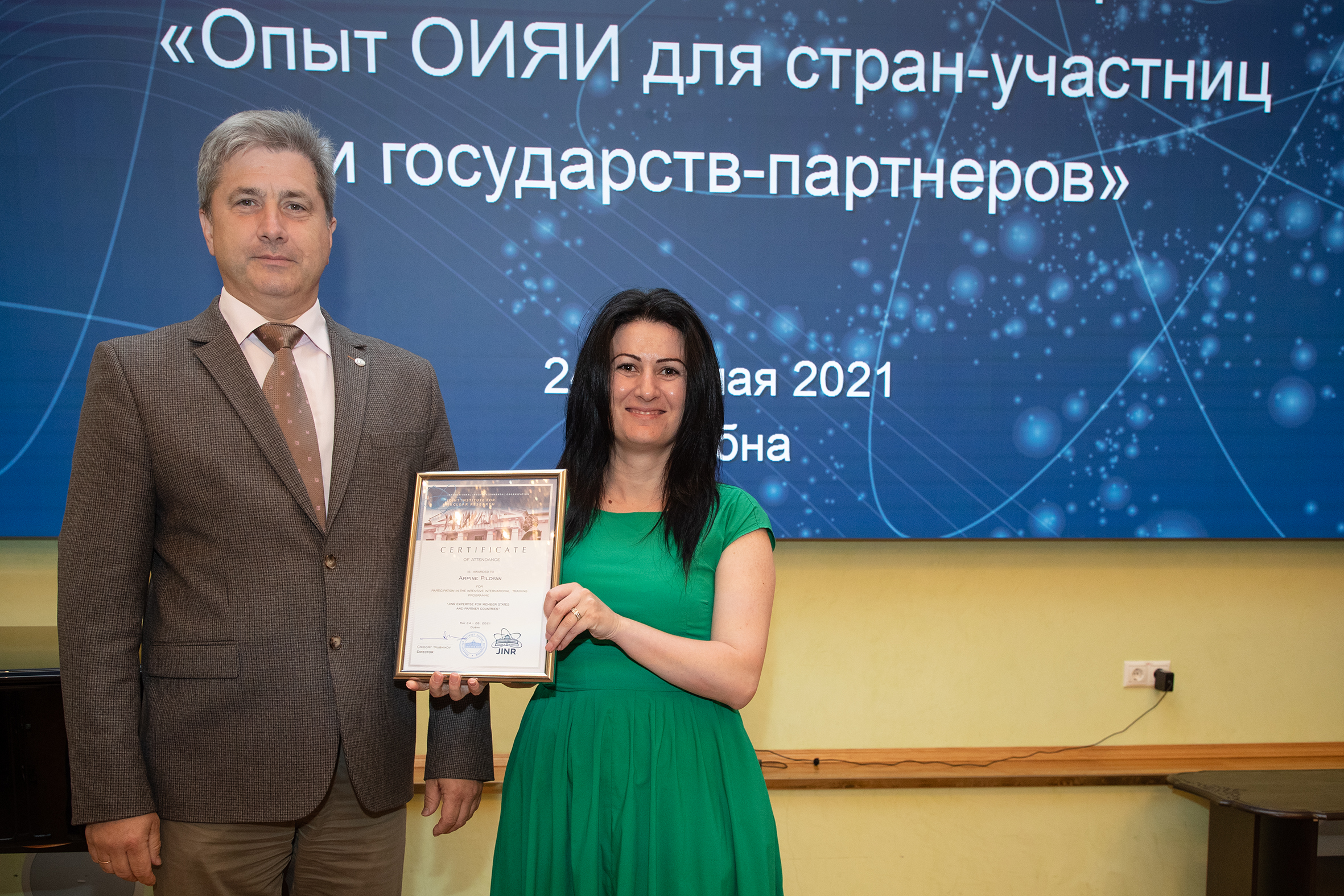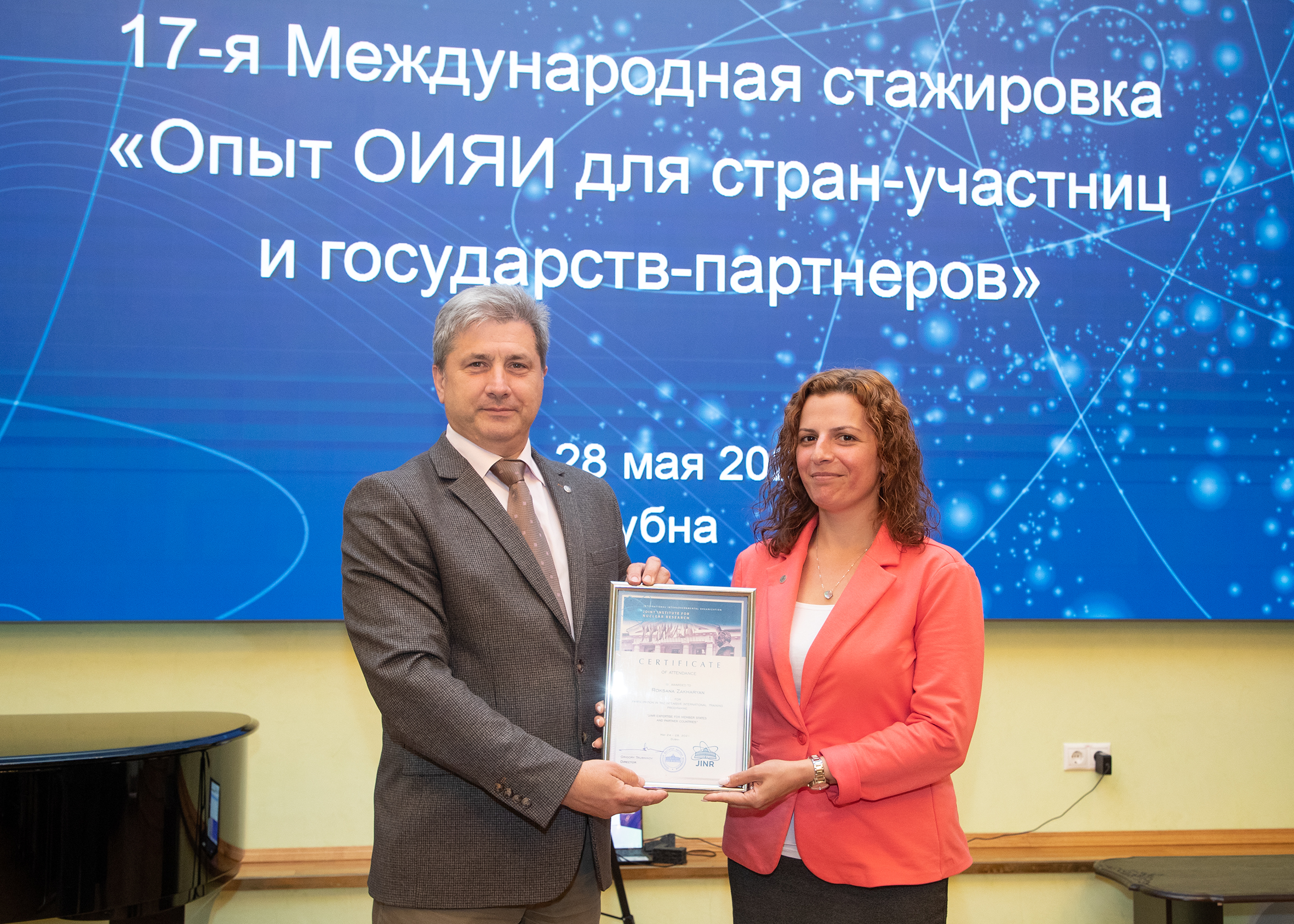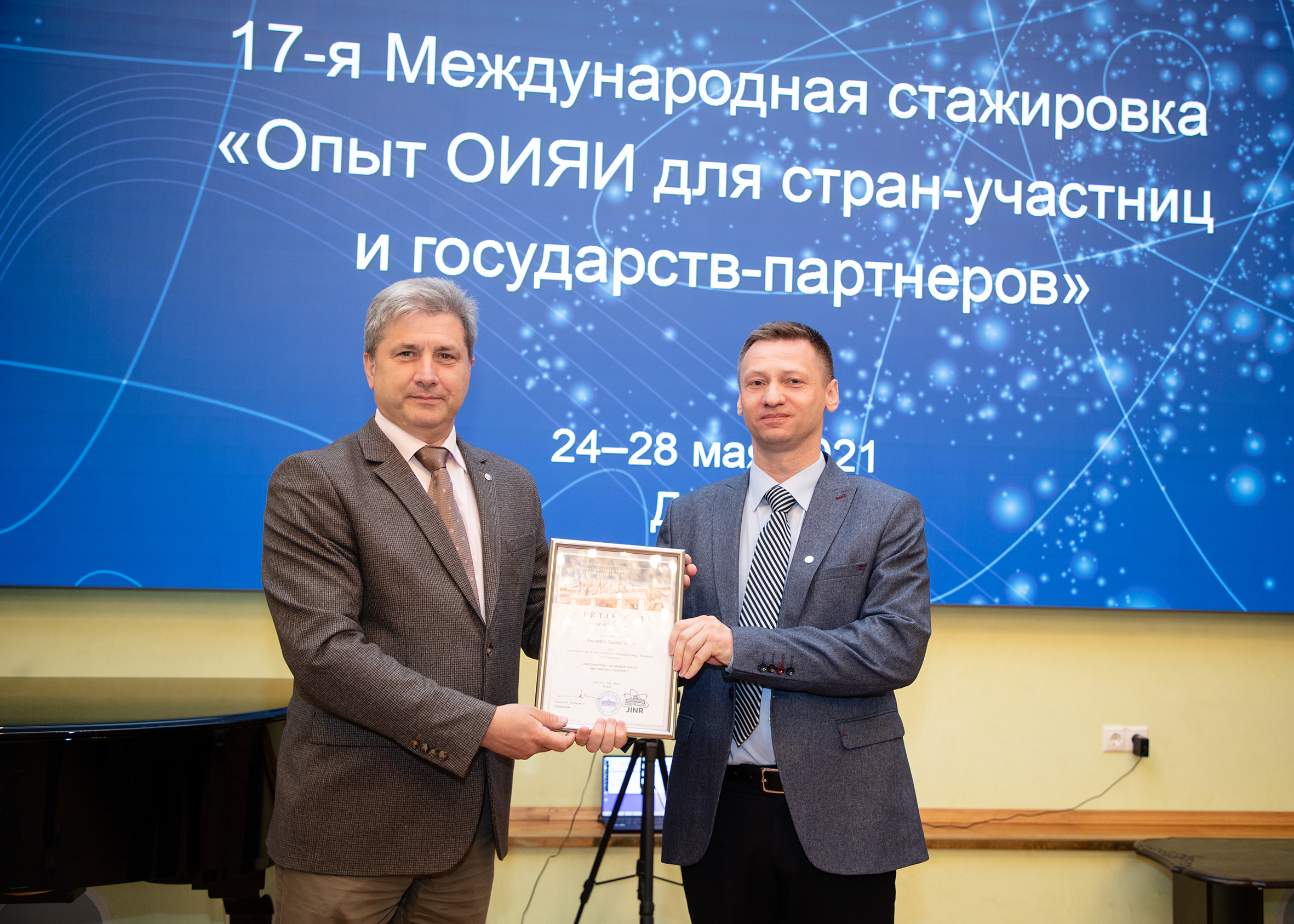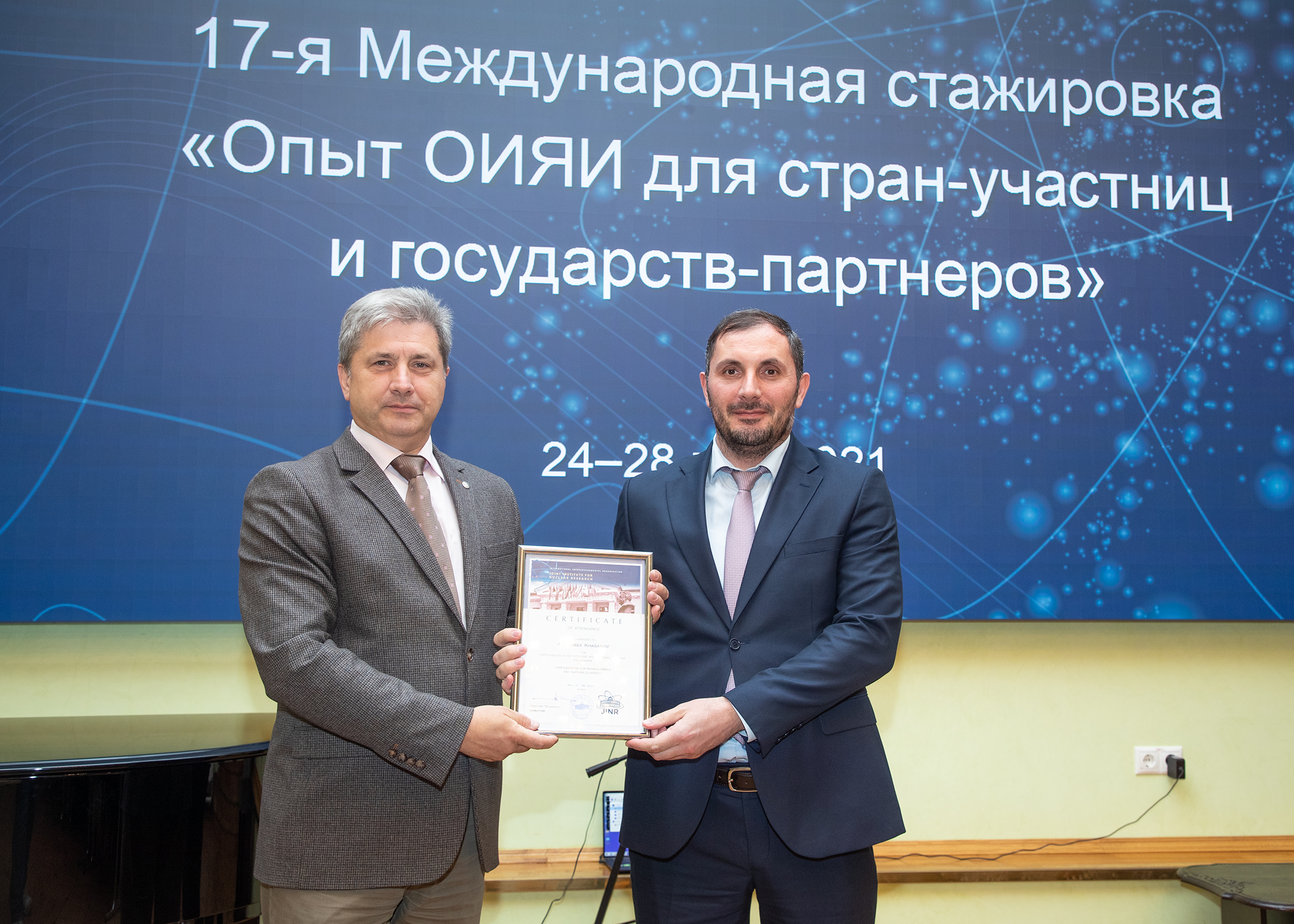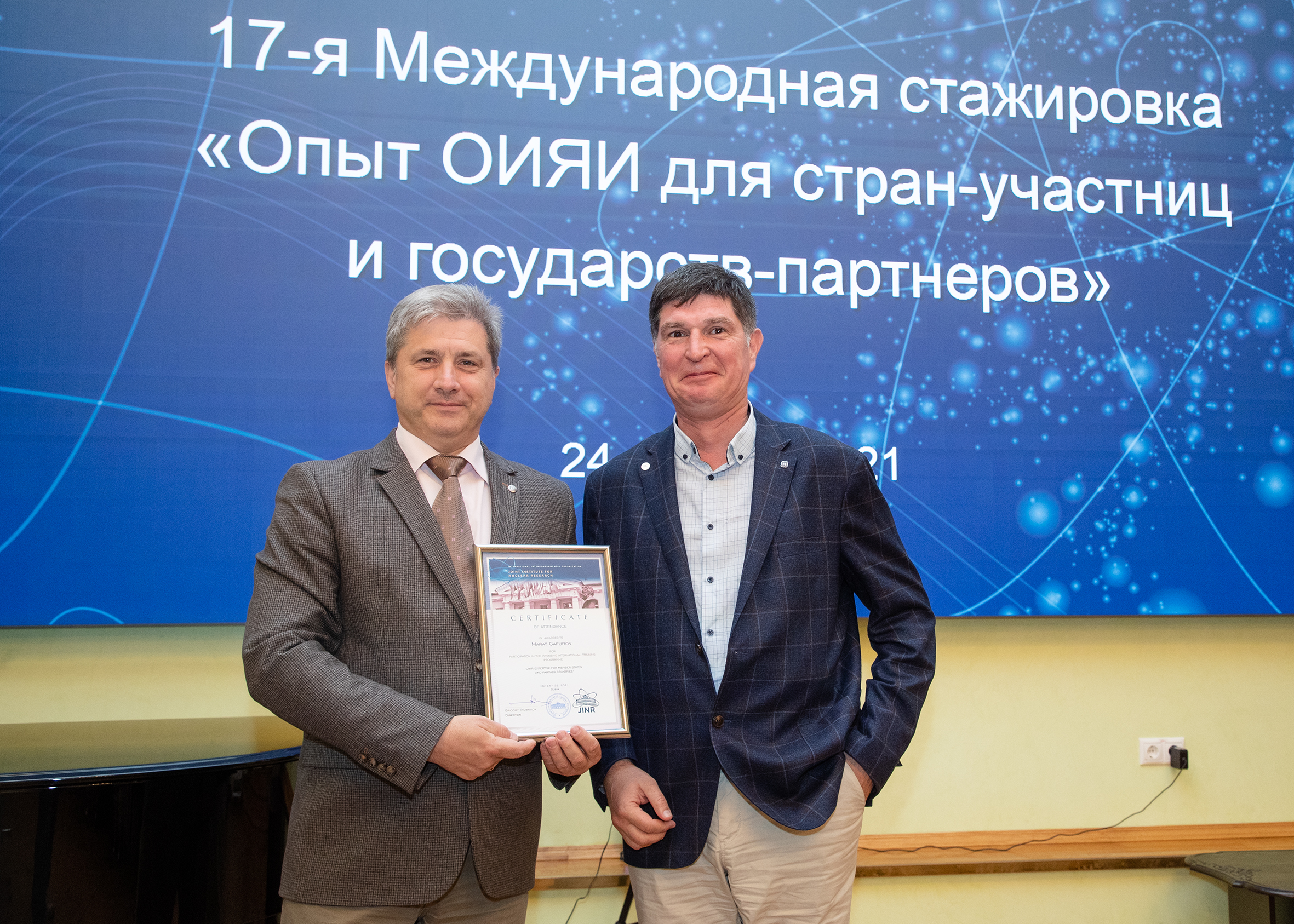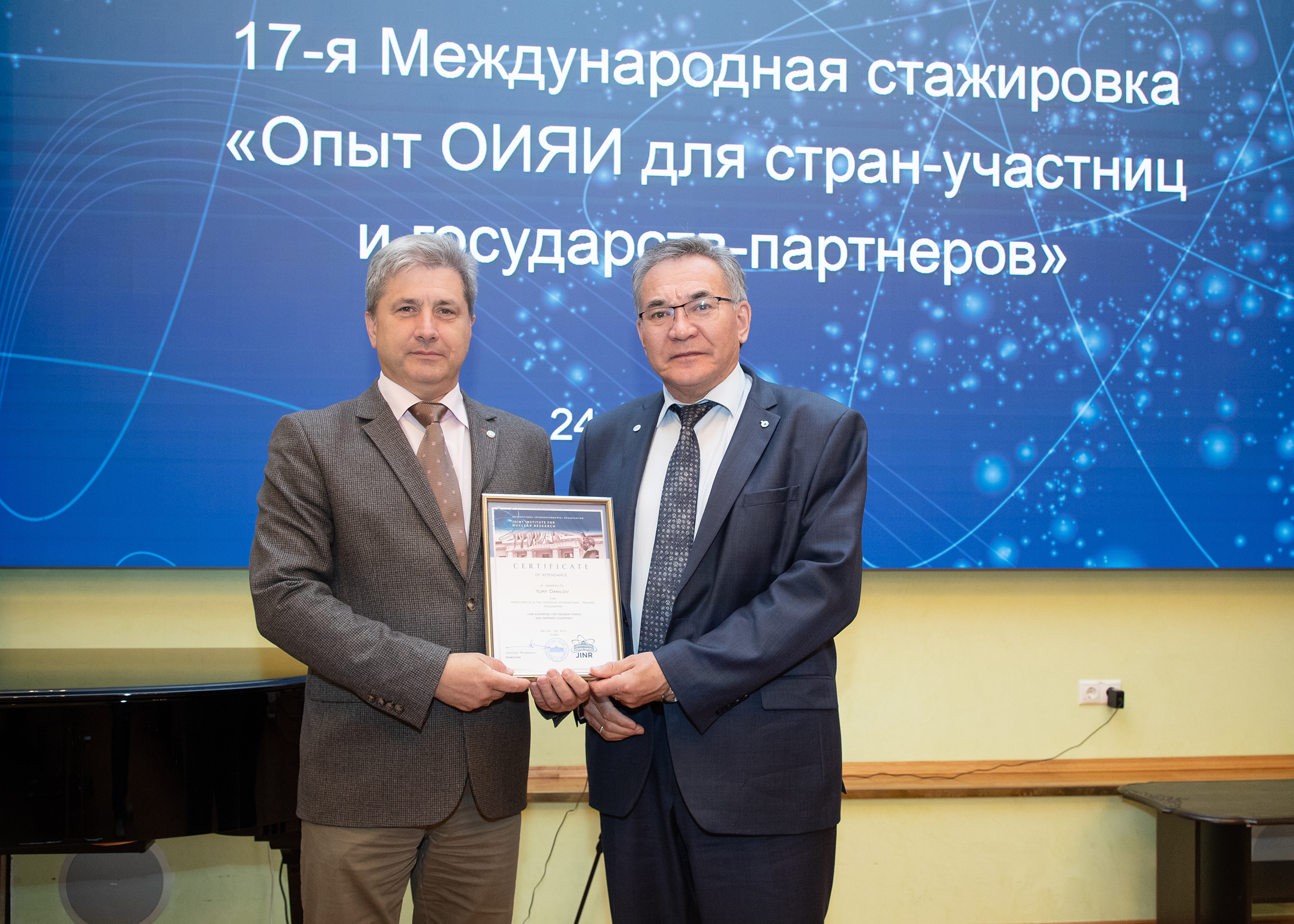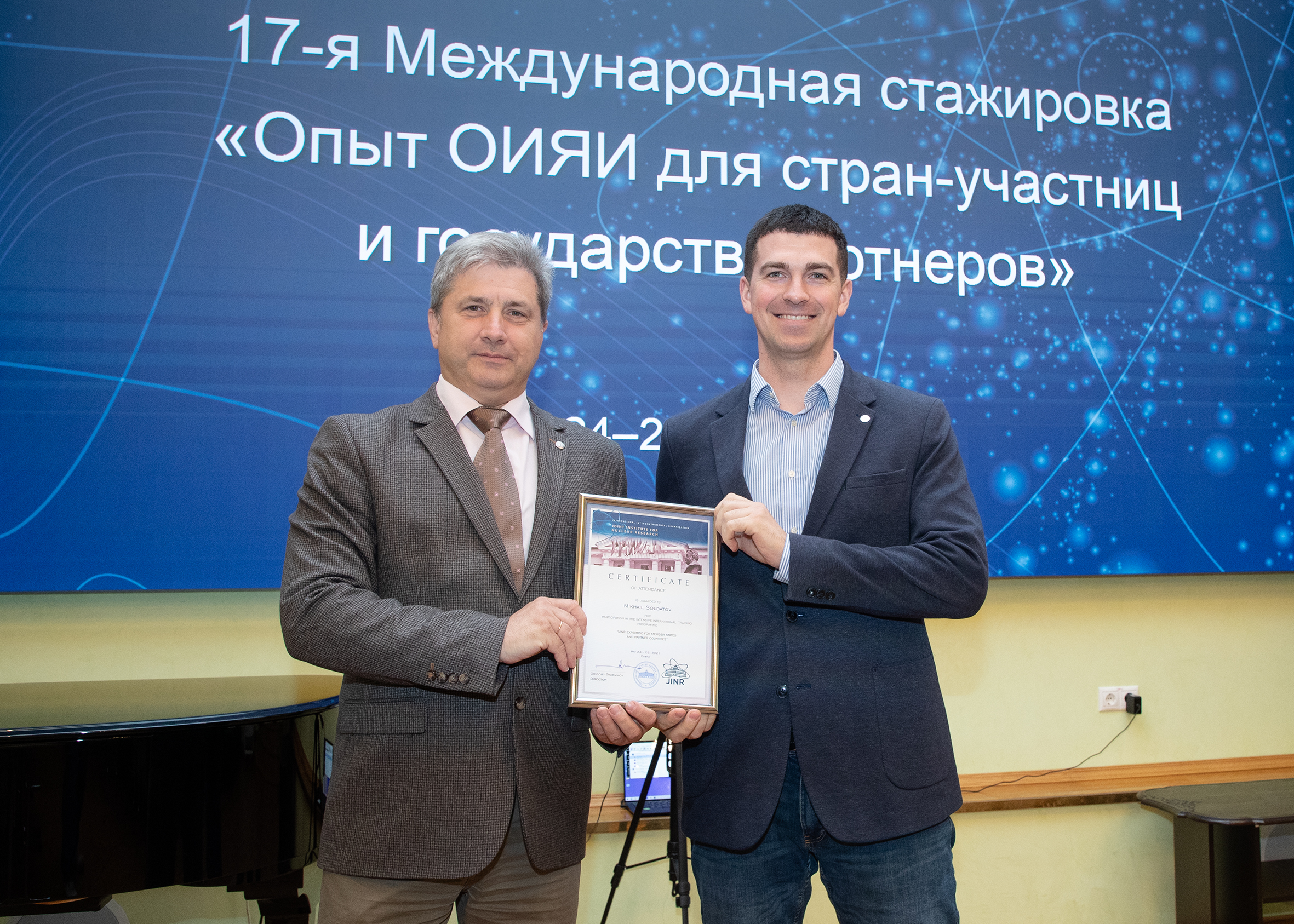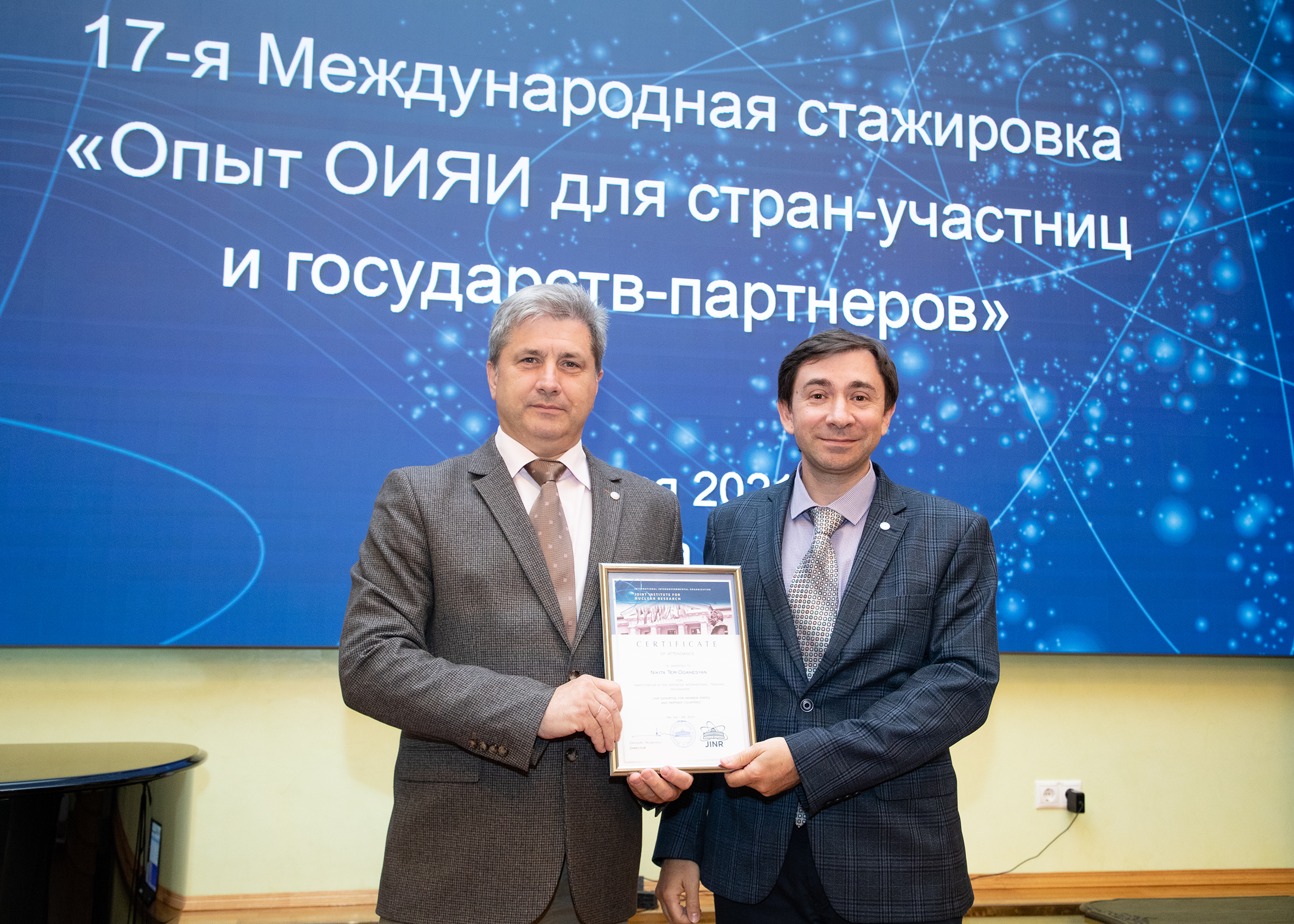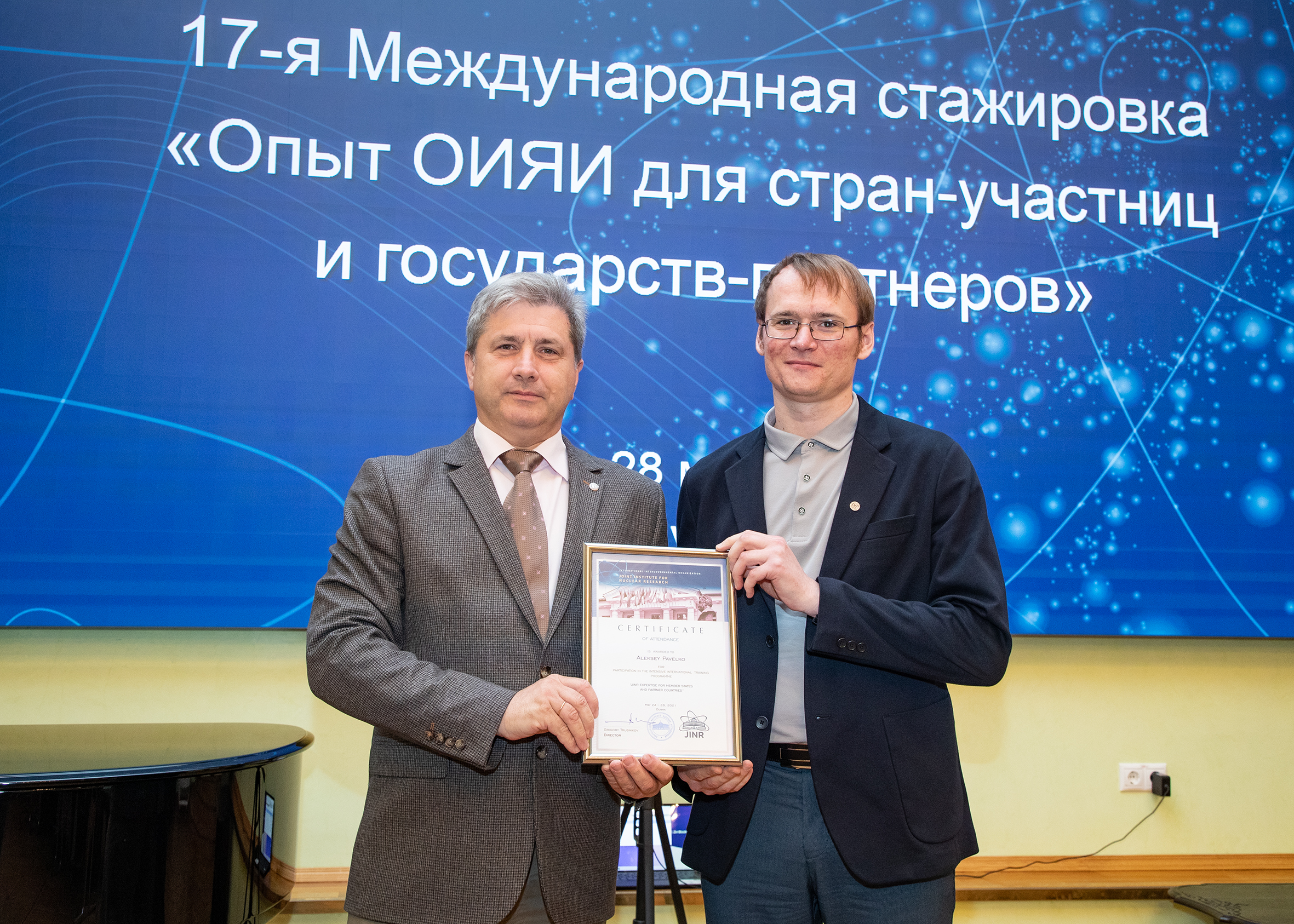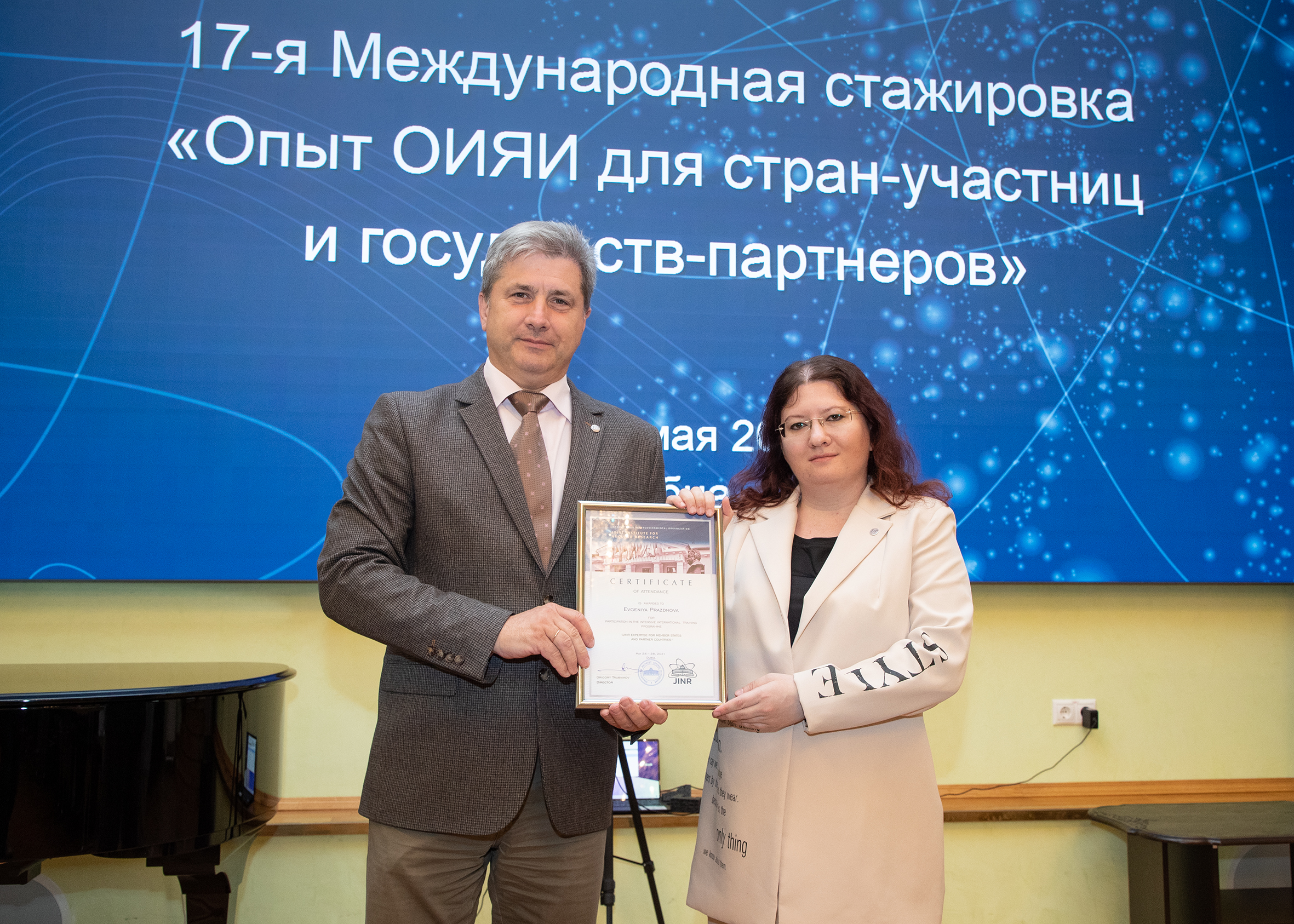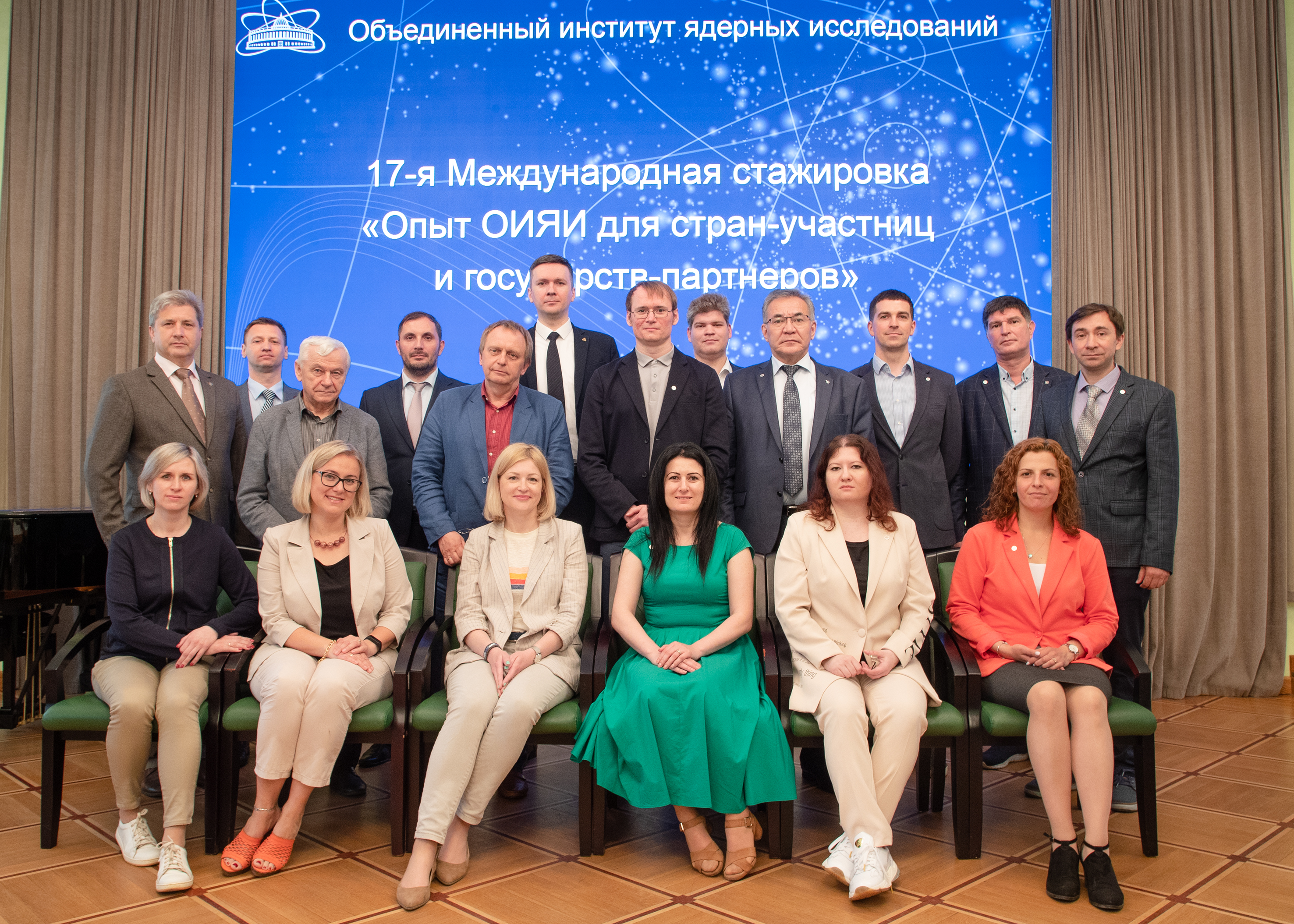JEMS-17: organizers appreciate feedback
News, 02 June 2021
On 24 – 28 May, the 17th International training programme for decision-makers in science and international scientific cooperation «JINR Expertise for Member States and Partner Countries» (JEMS-17) was held. This time there were mostly representatives of natural science areas of research centres, senior managers and heads of departments from universities of Armenia, Belarus, and the Russian Federation. Just like at the previous training programme, the working language of JEMS-17 was Russian. At the end of the internship, a traditional round table took place to exchange opinions: it is important for the organizers to get feedback, confirmation of the necessity of such events, and participants could specify once again particular topics on which mutually beneficial cooperation is possible.
JINR Chief Scientific Secretary Sergey Nedelko, VBLHEP Director R. Lednický, Head of the International Cooperation Department Dmitry Kamanin, Assistant Director of the Institute for the development of biomedical projects, RAS Corresponding Member G. Shirkov took part in the discussion.
Richard Lednický has been supervising the internships throughout all these years. The Information Centre in Vladikavkaz opened with his participation. He noted in the welcoming speech, “Experience shows that the creation of Information Centres in the Member States is of great significance for attracting young people to science, and not only to JINR. The Information Centre in Vladikavkaz has contributed to attracting students to the Faculty of Physics and Technology.” Then the VBLHEP Director spoke about the NICA mega-science project, physical tasks, collaborations created within the framework of the project, and invited young researchers to cooperate.
First but not last visit
When expressing impressions, participants unanimously recognized the warm welcome and good organization, the informative programme. Each participant expressed their gratitude to the organizers and the Institute’s staff who were informing, inviting, and ensuring the stay of participants. There were also unanimous statements about plans to establish closer contacts, form scientific groups in areas of interest, send young people for internships, contribute to the spread of information about the JINR activities.
Head of the Department of Physical Electronics of the Faculty of Physics and Mathematics at Chechen State University Aslambek Hasanov said that he was deeply impressed by research at JINR. He has already sent a part of the documents to colleagues, drafts of agreements to inform the rector. He also noted the IT School held in Vladikavkaz jointly with JINR as a positive experience. “This is our first but not the last visit,” A. Hasanov said.
Head of the Department of Bioengineering, Bioinformatics, and Molecular Biology at the Russian-Armenian University Roxana Zakharian noted the efficient format, rich programme, and useful educational sources, “I hope that despite the completion of the training programme, it will become the beginning of something bigger related not only to JINR but all other participants of the event.”
Deputy Head of the Faculty of Physics and Information Technologies of Francisk Skorina Gomel State University Andrey Samofalov, a specialist in theoretical physics, has found many scientific areas and equipment at JINR that he would like to apply in his research. In this regard, he is interested in submitting for participation in experiments with the use of the JINR basic facilities. “I saw many research areas, equipment, materials. My task is to describe all this, make links, and send this information to our biologists, geologists, physicists, mathematicians… Of course, we have already exchanged business cards with employees of your laboratories, but in addition to it, we have established close cooperation between colleagues who have gathered for the training programme… I have met colleagues from the SFU, they impressed me: they are young and creative.”
Another JINR outpost
The delegation of the Southern Federal University was indeed the most representative. Vice-Rector for Project and Design Activities and International Cooperation Evgeny Mukhanov noted that when implementing national projects related to science and universities, natural questions like “why” arise. The answer to this question became obvious at JINR: it is necessary to train specialists for centres important for the country to preserve its superiority, competitiveness in the world. E. Mukhanov noted, “We have discovered here a range of opportunities that will allow us, as a university, to implement this function of preparing research a little more correctly.” Holding various internships contributes to it: for school children who should understand that there is world-level science in Russia, for teachers to get inspired, for students who can study in detail their knowledge areas. This is all the more important because the SFU trains 78 per cent of teachers for the Rostov region. In addition, such fields as neutronography, life science, creation of bioprotectors evoked interest. The isotope analysis deserves special attention. It will be the basis for systematic cooperation in monitoring the state of the region’s soils. This is one of the most promising research areas of the University. E. Mukhanov said that drafting of the framework agreement with the Institute and the creation of one more JINR Information Centre in the SFU are underway.
Director of the SFU Research Centre of Intellectual Materials Mikhail Soldatov shared his impressions, “I am impressed by scientific schools, people working here, and tools. I hope that our cooperation will soon result in real joint scientific projects. We are most interested in projects with materials for biomedical studies, radioecology, energetics. Moreover, we would like to expand our experience in synchrotron research in the neutron field. I have seen a huge potential for supercomputing modelling. If we talk about the synchrotron experience, it is interesting to use artificial intelligence technologies for flow data processing collected at accelerators. Moreover, it is of interest to use the technologies of interactive virtual reality to create simulators for additional training of students and new employees.”
Director of the SFU Scientific and Research Institute of Physics Ilya Verbenko heads the Institute with a rich history. Many scientific fields overlap with JINR activities: radioecology, condensed matter physics, high-energy physics. That is why an opportunity to use JINR equipment and facilities is of special value. According to the Physical Scientific and Research Institute of the SFU Alexey Pavelko, the young man’s path to science goes through curiosity, surprise… Unfortunately, the world around us sets a too-high bar, which is difficult to overcome. JINR is exactly the place that helps, gives the energy to overcome it.
Head of the Laboratory of Experimental Mutagenesis at the SFU Academy of Biology and Biotechnology Evgenia Prazdnova noted the emerging inspiration “when one sees the passion of people talking about their beloved work. Even if this does not relate to my scientific field and not all the words are clear, it really inspires and stimulates the desire to work as hard as possible.” Three particular scientific fields for cooperation have been already identified after communicating with Dubna specialists. They relate to medicine and radioecological monitoring.
Endless world of communication
Of course, participants were recalling long-standing contacts with Dubna. Some of them knew about Dubna at second hand, some of them had already cooperated with the Institute. However, according to many of them, the reality has exceeded expectations. This fully applies to the range of scientific studies, unique equipment, the scale of conducted projects, the knowledge gained, the experience of communication. There was a case when a participant of the training programme learned about the work of a scientific group that was aiming for the same result but in other ways. There are already some agreements between participants on the creation of a grant system for students of various universities, but in a private form so far. The training programme was recognized as fruitful and useful. Each participant explained it with their own arguments, from their own points of view. The geography of participants is also remarkable: southern borders, the far north.
Deputy Director for Science of the Institute of Physics at Kazan Federal University Marat Gafurov shared his story, “My first acquaintance with Dubna took place when I came there to prepare my course work in our Laboratory. Just at the same time, specialists were installing a dissolution refrigerator for low temperatures and studies of helium-3, and our employee was serving a half-year internship in Dubna… At lectures, we were told that facilities had been operating and had not broken down since 1949. In 1973, we received the Dubna helium liquefier, and it still operates with your help… When in 2016, we were discussing the idea to create a joint department at our university, I was sceptical about Dubna and was thinking that there would be nothing useful – we were too different, the interests were drastically different. I should say that I was wrong. There are already good examples. Three our postgraduates work here now. As far as the university is multifunctional, there are good contacts with archaeologists, materials scientists. We want to keep working.”
Vice-Rector for Science and Innovation at the North-Eastern Federal University (Yakutsk) Yuri Danilov shared his opinion, “I have had a fairly shallow understanding of particles, dark matter so far, although I was interested in it and listened to science popular lectures. But I did not think that nuclear research penetrates almost all life aspects, starting from biology, geology… Our university is multidisciplinary: pedagogy, mathematics, history, archaeology, nanomaterials, genetics – there are many fields for cooperation. I think that we will soon send students and postgraduates here.”
Head of the Physics Department at the Karachaevo-Cherkessk University Murat Laipanov has sent us his comment, “All lectures and excursions were informative, for which I would like to thank you. It is an experience that is useful for me and our university. And I hope for further mutually beneficial cooperation in all areas. I cannot but mention opportunities of your resource edu.jinr.ru. It is a relevant and necessary solution, and I am sure that it will be useful for our educational process. We will definitely convey information about JINR to all interested people in our region.”
Mutual inspiration
And, probably, it is the inspiration, the charge of cheerfulness received in Dubna that explains the lively conversation, many initiatives, joking remarks, and mutual compliments made at this meeting. The cryogenist joked that Dubna was able to maintain the temperature, and the weather for these five days was excellent. To the words of a participant that not all institutions have complex and expensive devices, D. Kamanin suggested a different approach: you do have such devices! – referring to the opportunity to work in Dubna.
“I think the letter J in the Institute’s abbreviation means not only ‘joint’ but also ‘joyful and open’, a chief researcher of Scientific and Research Institute of Physics of the SFU Nikita Ter-Oganessian said. “Life is only possible in joyful and open systems constantly interacting with their environment. Dubna has a flow of energy of scientific search and people engaged in it. This flow will definitely lead to the birth of new scientific and educational ideas.
Scientific Secretary of Alikhanyan National Scientific Laboratory Arpine Piloyan assured that employees of various departments would come to Dubna, there would be a conference organized for the discussion of possible cooperation. She also concluded the following, “Archimedes said ‘Give me a fulcrum and I will move the Earth’. This acquaintance with the Institute is also a fulcrum for us that would provide many new opportunities.”
“You speak about your impressions in such a way as I am getting inspired,” S. Nedelko noted at the end of the meeting. “You are all from different places, it is clear that the scientific life is now vibrant. It is very joyful. And this also guarantees that our Institute will live.”
Galina Myalkovskaya
Photos by Igor Lapenko
